

Environment for Kids: Land Pollution. Science >> Earth Science >> EnvironmentWhat is land pollution?
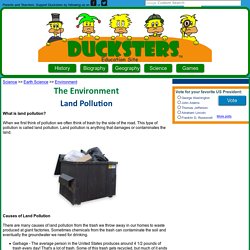
When we first think of pollution we often think of trash by the side of the road. This type of pollution is called land pollution. Land pollution is anything that damages or contaminates the land. Health and env effects air pollutions. Pollution. By 2000, the world’s chemical production had increased 400 fold since 1930.
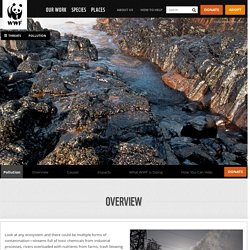
Chemicals have made much of modern life possible, but they’ve also contaminated landscapes around the world. They can travel great distances by air or accumulate in the bodies of animals and humans who absorb chemicals through the skin or ingest them in food or water. While some chemicals may be harmless, others can cause damage. Water Pollution. What is the biggest source of pollution in the ocean? Eighty percent of pollution to the marine environment comes from the land.
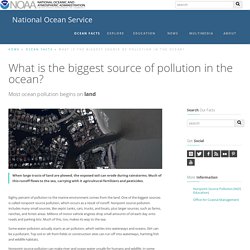
One of the biggest sources is called nonpoint source pollution, which occurs as a result of runoff. Nonpoint source pollution includes many small sources, like septic tanks, cars, trucks, and boats, plus larger sources, such as farms, ranches, and forest areas. Millions of motor vehicle engines drop small amounts of oil each day onto roads and parking lots. Water pollution. Water pollution is the contamination of water bodies (e.g. lakes, rivers, oceans, aquifers and groundwater).
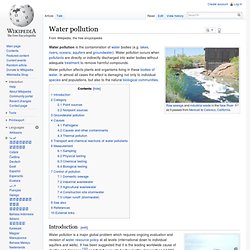
Water pollution occurs when pollutants are directly or indirectly discharged into water bodies without adequate treatment to remove harmful compounds. Water pollution affects plants and organisms living in these bodies of water. In almost all cases the effect is damaging not only to individual species and populations, but also to the natural biological communities. Introduction[edit] Water pollution is a major global problem which requires ongoing evaluation and revision of water resource policy at all levels (international down to individual aquifers and wells). Water is typically referred to as polluted when it is impaired by anthropogenic contaminants and either does not support a human use, such as drinking water, or undergoes a marked shift in its ability to support its constituent biotic communities, such as fish. Category[edit] Point sources[edit] Nonpoint sources[edit] How Does Your Plastic Bag Get Into the Ocean?
If you live hundreds of miles away from the coast, it probably never occurs to you that the plastic bag or cup lid that you toss into the gutter might make its way into the Atlantic or the Pacific.
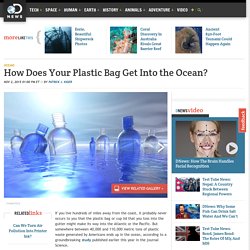
But somewhere between 40,000 and 110,000 metric tons of plastic waste generated by Americans ends up in the ocean, according to a groundbreaking study published earlier this year in the journal Science. It's difficult to pinpoint where all that refuse originates, and researchers think that much or most of it probably comes from the nation's densely-populated coastlines. But there's also evidence that the nation's inland waterways serve as a conduit for plastic to travel thousands of miles into the oceans. PHOTOS: The Great Atlantic Garbage Patch. Plastics in the Ocean Affecting Human Health. Author: Gianna Andrews This case study is part of a collection of pages developed by students in the 2012 introductory-level Geology and Human Health course in the Department of Earth Sciences, Montana State University.
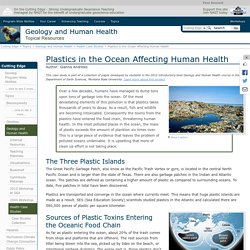
Learn more about this project. Mountain of Plastic. Pollution. Introduction of contaminants that cause adverse change. 20 Facts About Ocean Pollution. The ocean remains one of the most expansive, mysterious and diverse places on Earth.
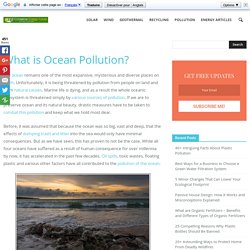
Unfortunately, it is being threatened by pollution from people on land and from natural causes. Marine life is dying, and as a result the whole oceanic ecosystem is threatened simply by various sources of pollution. If we are to preserve ocean and its natural beauty, drastic measures have to be taken to combat this pollution and keep what we hold most dear. Before, it was assumed that because the ocean was so big, vast and deep, that the effects of dumping trash and litter into the sea would only have minimal consequences.
But as we have seen, this has proven to not be the case. Simply put, the ocean cannot continue to thrive as a dump site for people. China’s Other Pollution Problem: Water. Why are rainforests being destroyed? Scientists: air pollution led to more than 5.5 million premature deaths in 2013. Air pollution caused more than 5.5 million people to die prematurely in 2013, according to research presented on Friday, with more than half of those deaths in India and China and illnesses in those countries almost certain to rise.
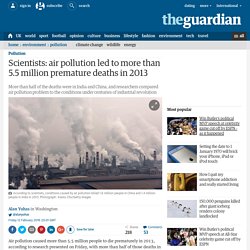
Scientists support ban on microplastics. Why is Plastic Pollution a Problem in Our Oceans? A sea turtle spots a plastic bag floating among the waves.
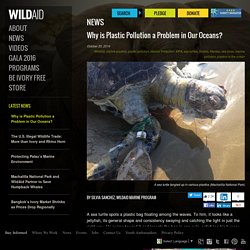
To him, it looks like a jellyfish, its general shape and consistency swaying and catching the light in just the right way. He swims toward it and ingests the bag in one gulp, satisfying his hunger, and then goes on his away. In actuality, that plastic bag lines his gut, causing digestive blockages and the sea turtle’s eventual death from starvation. This is why a sea turtle could confuse a plastic bag with a jellyfish (Plastic Pollution Coalition) This story is all too common in the marine environment.
Only 9% of plastics in the United States are recycled, and since most are not biodegradable, much of this refuse floats around for years, breaking down into smaller and smaller pieces that are invisible to the naked eye. WildAid currently works with marine parks throughout Ecuador to remove ghost nets and discarded fishing line from the sea during regular patrols. The Story of Bottled Water. The Story of Bottled Water, released on March 22, 2010 (World Water Day), employs the Story of Stuff style to tell the story of manufactured demand—how you get Americans to buy more than half a billion bottles of water every week when it already flows virtually free from the tap.
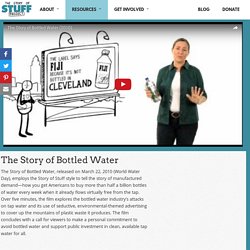
Over five minutes, the film explores the bottled water industry’s attacks on tap water and its use of seductive, environmental-themed advertising to cover up the mountains of plastic waste it produces. The film concludes with a call for viewers to make a personal commitment to avoid bottled water and support public investment in clean, available tap water for all. Credits. The Story of Microfibers - The Story of Stuff Project. Most of us wear synthetic fabrics like polyester every day. Our dress shirts, yoga pants, fleeces, and even underwear are all increasingly made of synthetic materials — plastic, in fact. But these synthetic fabrics, from which 60% of all clothing on earth is made, have a big hidden problem: when they’re washed, they release tiny plastic bits — called microfibers — that flow down our drains, through water treatment plants, and out into our rivers, lakes and oceans by the billions.
Go deeper: Microfibers FAQs Script with Citations Microfibers Research Guide Credits.